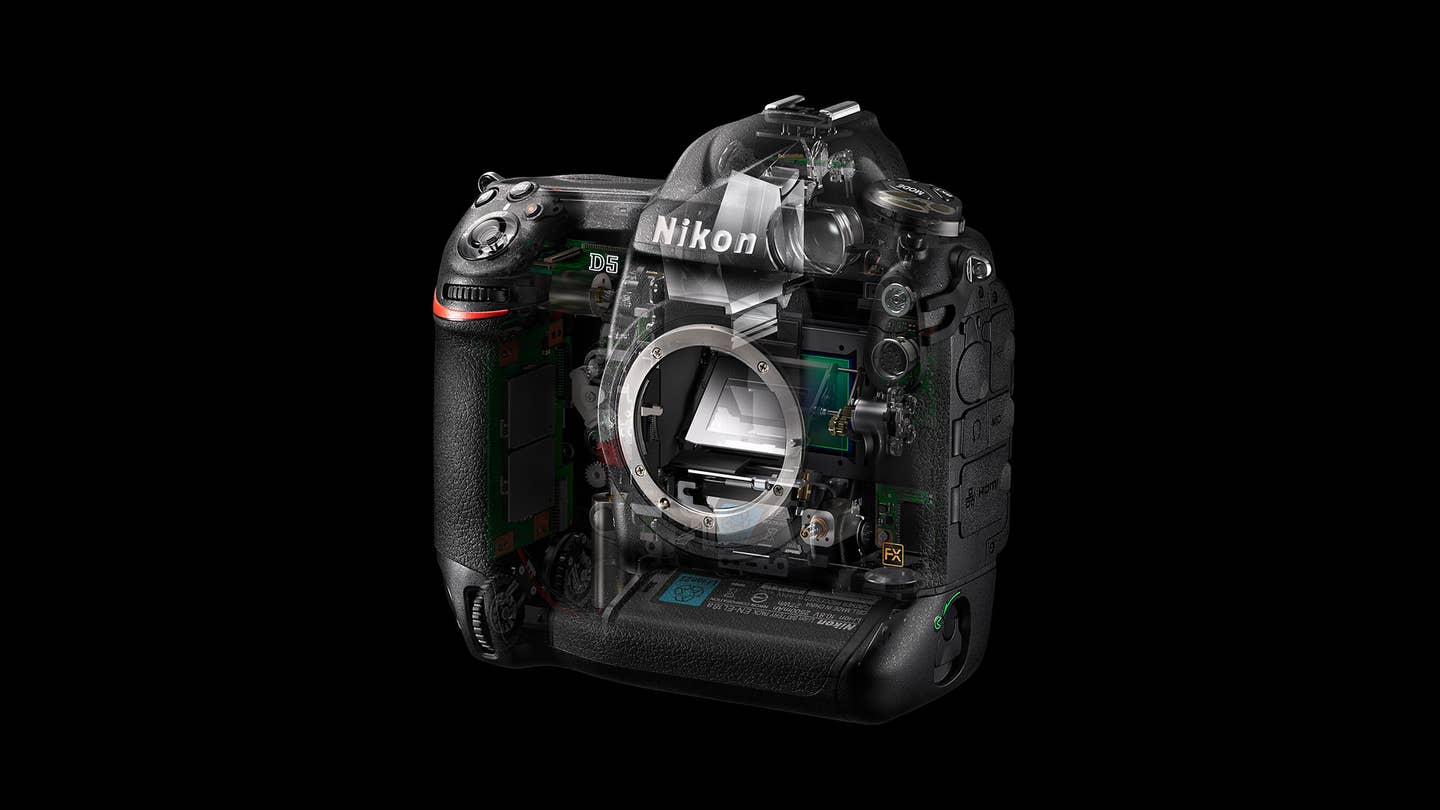Nikon D5 Can Change Automotive Photography Forever
The baddest-ass Nikon ever can shoot in near-darkness. And that’s only one reason this beast is a massive tech upgrade.

We may earn revenue from the products available on this page and participate in affiliate programs. Learn more ›
Why am I so hot on the new Nikon D5? You don’t have to be a camera dork to know the landscape of professional-level cameras has shifted. Well, okay, maybe just a little bit of a dork. See, this past year Sony debuted the Alpha 7R II, a $3,200 mirrorless monster that was supposed to be the final nail in the SLR coffin.
Huh? Say that again in English, please.
O.K., here’s the skinny on mirrorless vs. mirrors, the basis of why the D5 matters: Mirrors take up space.
That classic pentaprism at the top of single-lens-reflex cameras is used to bounce light from what the lens sees to your eye. It’s an invention dating back six-plus decades. But glass, plus the mechanics of a shutter that moves (“reflex”), add bulk and weight. By switching from film to digital—and the advent of LCD viewfinders, instead of reflecting the light the lens captures to a viewfinder—camera makers have managed to reduce mechanical complexity. That has shrunk the footprint and, a la that mighty Sony, meant a super-fast shutter at five frames per second, too. No moving parts = “mirrorless” miracle.
There’s much more that mirrorless tech allows, but this new Sony looked to be the death of DSLRs. Not so fast. At the Consumer Electronics Show last week, Nikon punched back with the (albeit twice as expensive) D5. And, man, the DSLR is so not dead. Nothing else will shoot faster in less light. Oh, and it can capture 4K video, just for kicks.
More granularly, like the Sony, the Nikon D5 has a base ISO range from 100 to 102,400. And while you can expand that range up to a freakish 409,600 ISO (five stops) with the Sony, the Nikon is expandable up to 3,280,000 ISO. What Nikon has touted as “night vision” is still something I’ll need to test in order to believe, but this capability alone is a game changer. Because it should allow shooting stuff like 24-hour endurance racing in near darkness without worrying about blur. In fact, at CES, Nikon blew up shots of water polo—yes, water polo—taken at dusk at over 10,000 ISO. You could see individual drops of water on the players eyelashes. Yet the highlights of the image, blown up to 30x30 feet (!), weren’t overexposed.
As for speed, the Nikon D5 can shoot 12 frames per second at 20.8 megapixels, and save a JPG sample at the same time. (You can also hold the shutter down for 200 frames at this recording level, which is essentially half the speed of normal video, with autofocus tracking on). Translation: If you’re shooting auto racing, you can just follow the action with the shutter held down as cars sweep by, and almost certainly drag out great shots.
The Nikon’s 4K video (four times HD, which is 1080p), can be shot at 30 frames per second, and 1080 at 60fps, same as the Sony.
True, the Sony still “matters,” especially to mere mortals who aren’t pro shooters. That’s not just down to tech, but also size: At 1.38 pounds, it’s less than half the heft of the 3.1-lb. Nikon, and the body is about 40 percent smaller and thinner. “Mine is bigger” isn’t a boast you’re going to make about a camera. So the next step for Nikon will be to shrink all this tech into something more consumer friendly.
Oh, wait, they did that already.
Because while the D5 sucked all the oxygen out of the press Nikon quietly also debuted the D500, which gets the same sensor tech in a smaller, lighter package. It goes on sale for $2,000 in March. And while it’s not quite the D5, it’s a direct shot at Sony’s mirrorless dominion.
All of which means no matter what you choose, Sony or Nikon (or any day now, Canon) you’re going to make better pictures, period.
